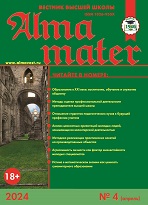UDC 316:37-053.2
https://doi.org/10.20339/AM.06-22.047
Nataliia A. Mikhalchenkova, Dr. Sci. (Politics), Professor, Scientific supervisor “All-Russian Pedagogical Workshop”, Moscow, e-mail: mehedova@yanbex.ru
The article discusses the tasks of implementing the federal state standard for preschool education; analyzes the strategic objectives of the educational program of a preschool institution; the principles and methodological approaches of designing an educational program for a preschool institution are revealed. The educational areas of the preschool program are identified: social and communicative development, cognitive development, speech and physical development, artistic and aesthetic development of the child’s personality.
Key words: education, preschool institution, educational program.
References
- Barnett, W.S. Benefits and costs of quality early childhood education. Legal Rights Journal. 2007. No. 27 (1). Р. 7–23.
- Barnett, W.S., Frede, E.C., Mosbasher H., Mohr, P. The efficacy of public preschool programs and their relationship of program quality to efficacy. Educational Evaluation and Policy Analysis. 1987. № 10 (1). P. 37–49.
- Barnett, W.S., Jung, K., Yarosz, D.J., Thomas, J., Hornbeck, A., Stechuk, R., Burns, S. Educational effects of Tools of the Mind curriculum: A randomized trial. Early Childhood Research Quarterly. 2008. No. 23 (3). P. 299–313.
- Belsky, J., Melhuish, E. Impact of Sure Start Local Programmes on children and families. In: J. Belsky, J. Barnes, & E. Melhuish (eds.) The National Evaluation of Sure Start: Does Area-Based Early Intervention Work? Bristol, UK: The Policy Press, 2007. P. 133–154.
- Berrueta-Clement, J., Barnett, W., Schweinhart, L., Epstein, A., Weikart, D. Changed lives: The effects of the Perry Preschool Program on youths through age 19. Monograph of the High/Scope Educational Research Foundation No. 8. Ypsilanti, MI: High/Scope Press, 1984. 224 p.
- Bowman, B.T., Donovan, M.S., Burns, M. Eager to learn: Educating our preschoolers. Washington, DC: National Research Council, 2001. 340 p.
- Gilliam, W.S., Zigler, E.F. A critical meta-analysis of all evaluations of state funded preschool from 1977 to 1998: Implications for policy, service delivery and program evaluations. Early Childhood Research Quarterly. 2000. No. 15. P. 441–473.
- Karoly, L.A., Greenwood, P.W., Everingham, S.S., Hoube, J., Kilburn, M.R., Rydell, C.P. Investing in our children: What we know and don’t know about the costs and benefits of early childhood interventions. Santa Monica, CA: RAND, 1998. Р. 278.
- Magnuson, K., Meyers, M., Ruhm, C., Waldfogel, J. Inequality in Preschool Education and School Readiness. American Educational Research Journal. Spring 2004. Vol. 41. No. 1. P. 115–157.
- Preschool education practice guidelines for preschool teachers. State of Israel. Ministry of education preschool education division. 2020. P. 84.
- Reynolds, A.J. Effects of a preschool plus follow-on intervention for children at risk, Developmental Psychology. 1994. No. 30 (6). P. 787–804.
- Reynolds, A.J. One year of preschool intervention or two: Does it matter? Early Childhood Research Quarterly. 1995. No. 10. P. 1–31.
- Reynolds, A.J., Temple, J.A., Robertson, D.L., Mann, E.A. Long-term effects of an early childhood intervention on educational achievement and juvenile arrest: A 15-year follow-up of low-income children in public schools. Journal of the American Medical Association. 2001. No. 285 (18). Р. 2339–2346.
- The Preschool Curriculum. Combined_Pre_school_curriculumEng.pdf (accessed on: 29.11.2021).
- Order of the Ministry of Education and Science of the Russian Federation of 17/10/2012 No. 1155 (as amended on 21.01.2019) “On Approval of the FGOS Preschool Education — FGOS (fgos.ru) (accessed on: 29.11.2021).











.png)






